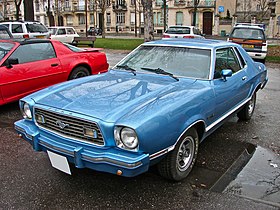Our website is made possible by displaying online advertisements to our visitors.
Please consider supporting us by disabling your ad blocker.
Ford Mustang (second generation)
| Second generation | |
|---|---|
 Ford Mustang II coupe | |
| Overview | |
| Manufacturer | Ford |
| Also called | Ford Mustang II Ford T5 (in Germany)[1] |
| Production | 1973–1978 |
| Model years | 1974–1978 |
| Assembly |
|
| Designer | Buck Mook, Dick Nesbitt |
| Body and chassis | |
| Class | Pony car Subcompact car[2][3][4] |
| Body style | |
| Layout | Front-engine, rear-wheel-drive |
| Related | |
| Powertrain | |
| Engine | |
| Transmission | |
| Dimensions | |
| Wheelbase | 96.2 in (2,443 mm) |
| Length | 175.0 in (4,445 mm)[5] |
| Width | 70.2 in (1,783 mm) |
| Height | 2-door: 50.3 in (1,278 mm) 3-door: 50.0 in (1,270 mm) |
| Chronology | |
| Predecessor | Ford Mustang (first generation) |
| Successor | Ford Mustang (third generation) |
| This article is part of a series on the |
| Ford Mustang |
|---|

The second-generation Ford Mustang, marketed as the Ford Mustang II, is a two- or three-door, four-passenger, front-engine/rear-drive pony car manufactured and marketed by Ford from 1973 until 1978. Introduced in September 1973 for the 1974 model year, the Mustang II arrived roughly coincident with the oil embargo of 1973 and subsequent fuel shortages.[6] Developed under Lee Iacocca, it was an "entirely new kind of pony car."[7] Ford "decided to call it Mustang II, since it was a new type of pony car designed for an era of high gas prices and fuel shortages."[8]
The Mustang II was 490 lb (222 kg) lighter and almost 19 in (483 mm) shorter than the 1973 Mustang, and derived from the subcompact Pinto platform. While sharing a limited number of driveline components with the Pinto, the Mustang II employed an exclusive subframe, isolating its front suspension and engine mount subframe. The steering used a rack-and-pinion design.
Named Motor Trend's 1974 Car of the Year and reaching over 1.1 million sales over four years of production, the Mustang II is noted simultaneously for both its marketing prescience and strong sales – while regarded by certain enthusiasts as having abandoned essential aspects of the Mustang heritage and in a retrospective after 40 years since its introduction described as embodying the Malaise era.[9][10]
- ^ Ral, Patrick (October 16, 2013). "Ford Details the German Ford Mustang That Never Wore the Mustang Name". torquenews.com. Retrieved December 8, 2021.
- ^ "Tested: 1974 Ford Mustang II Mach Car and Driver". September 1, 1973. Retrieved July 19, 2023.
- ^ "I like this Mustang, Too". Hemmings Motor News. September 23, 2018. Retrieved July 19, 2023.
- ^ "Was the Pinto-Based Mustang II So Terrible After All?". motortrend.com. Retrieved July 19, 2023.
- ^ "1976 Ford Mustang II Brochure". oldcarbrochures.com. December 1975. p. 6. Retrieved 30 September 2020.
- ^ Farr, Donald (16 April 2014). "Best Mustangs of 1974–1978: Generation of IIs". motortrend.com. Retrieved 30 April 2023.
Mustang II first arrived in Ford showrooms in late summer of 1973
- ^ McGuire, Bill (21 January 2021). "Marketing the 1974 Ford Mustang II". macsmotorcitygarage.com. Retrieved 30 April 2023.
- ^ Foster, Patrick (21 December 2007). "1974". oldcarsweekly.com. Retrieved 30 April 2023.
- ^ "Mustang II Forty Years Later". media.ford.com (Press release). 17 September 2013. Retrieved 30 April 2023.
- ^ Tate, Robert (15 July 2020). "The Ford Mustang II for 1974–78 Was New Generation Styling". motorcities.org. Retrieved 30 April 2023.
For many years, automotive historians and consumers had mixed reviews of the Mustang II, due mostly to the styling of the next generation Pony car. However, the 1974 Mustang did win Motor Trend's prestigious Car of the Year award.
Previous Page Next Page


